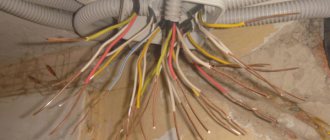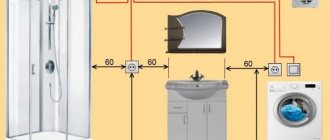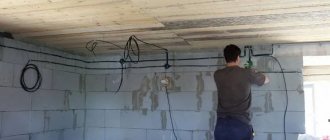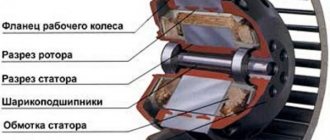It is difficult to imagine our daily life without electricity. This invention brought man to a new level of life, to a new level of thinking and development. For many of us, electricity seems like some kind of magic, because most have no idea how electricity is produced, how it is distributed and functions. At the same time, we need this knowledge both for everyday and professional activities.
Our site is designed for a wide range of readers, among whom there are both theorists and practitioners. This is an information resource created by a candidate of electrical engineering sciences, so you can be confident in the accuracy and completeness of the information. In special sections you will find interesting facts, instructions, diagrams and detailed descriptions for solving various electrical problems. In addition, you will be able to study feature articles that are easy to read because they are written in clear language.
What is electricity
Electric current is the movement of charged particles (electrons), which, like any movement, can be directed to perform useful work. 2 basic units of electricity:
- this is the voltage (measured in volts and denoted by the letter B or Latin V);
- current strength (measured in amperes and denoted by the letter A).
For simplicity, let's compare electricity to water flowing through pipes. Using the example of water, voltage can be understood as the force with which water is pushed out of a source (pump), and current strength can mean the amount of water passing per unit time through a section of a pipe of a certain diameter (wire cross-section). As in the case of water in electrical engineering, the cross-section of the wire is selected depending on the strength of the current - an incorrectly selected wire will simply burn out when a current of greater strength passes through it than it was designed for. It should also be noted that electric current can only flow in a closed circuit and can be constant or variable. Let's look at this point in more detail.
Electric current is the movement of charged particles
Direct current flows in one direction from the positive pole of the source (+) to the negative (-), while alternating current changes the direction of movement at a given frequency. Frequency is another unit of measurement that only applies to alternating current. Essentially this is the number of changes in the direction of current movement per second. Frequency is measured in Hertz and is denoted by the letters Hz, or the Latin Hz. So in a household electrical network, the current frequency is 50 hertz, that is, the current changes its direction 50 times per second. It’s worth telling a little more about alternating current. So in a household single-phase electrical network there are 2 wires - one of them is a phase (it is the current that is supplied to it from the power plant), the second wire is a neutral wire. Essentially, 0 is an empty wire through which the current returns back to the power source (as we remember, electricity can only flow in a closed circuit), but from a safety point of view. You shouldn't rely on this. For example, in a closed circuit, dangerous voltage is present on both wires. In general, caution is the main rule when working even with seemingly low and safe voltage. Having dealt a little with the theory (which we will return to later), let’s move on to more practical things that will be useful in further work with electricity.
Video - What is electricity
Legend
As in other areas, in electrical engineering there are generally accepted conventions, the main ones of which we will now get acquainted with - they will be useful for further work with electrical devices and networks. Below will be given the symbols and explanations for them, starting with the simplest ones, gradually moving to more complex ones.
Fig.1 Designation of a simple intersection of conductors
Fig.2 Designation of connection with crossing conductors
Figures 1 and 2 show outwardly similar, but fundamentally different symbols. However, schematic images of electrical and often radio elements are usually intuitive. So it’s not difficult to guess that Figure 1 shows a simple intersection of conductors, and Figure 2 shows their connection.
Fig.3 Switch designation
Fig.4 Designation – fuse
Also intuitive are Figures 3 and 4, which show a switch (Figure 3) and a fuse (Figure 4). It’s worth staying a little longer on the fuse - it’s an inconspicuous, but quite necessary detail, which often allows you to avoid serious troubles. The purpose of the fuse, as the name suggests, is to protect wiring and equipment from damage and fire. The fuse consists of a dielectric (non-current-permeable) tube and a conductor inside it. This conductor is designed for a current strength that is slightly less than the circuit it is designed to protect can withstand, and in cases of a voltage surge to a dangerous level, the fuse simply melts, thereby opening the circuit and protecting devices or wires from serious damage or ignition.
The following designations may not be so clear, but. I think many people I know from my school physics course.
RSI.5 Designation – light bulb
This is an incandescent lamp, also known as a regular electric light bulb (Figure 5).
Fig.6 Designation - resistance
Fig.7 Designation - LED
Fig.8 Designation – semiconductor diode
A resistor (in everyday life - resistance, Fig. 6), here, perhaps, we will add an LED, which is increasingly replacing ordinary light bulbs (Figure 7), as well as the element that gave the name to the LED - a semiconductor diode (Figure 8). I’ll tell you more about the LED - it got its name due to the properties of a semiconductor diode - passing current only in one direction - from the anode to the cathode (we are now talking about direct current). That is, when the positive pole of the power source is connected to the anode, current will pass through the diode, but when the negative pole is connected, the current does not pass and the circuit remains open. This property of the diode is shown in more detail in Figure 9 below.
Fig. 9 Designations of diode properties
No less important elements of electrical circuits are power connectors. Here is the simplest option - a socket (Figure 10) and a plug (Figure 11).
Fig. 10 Designation – socket
Fig. 11 Designation - plug
Now, knowing the schematic images of some basic elements, you can try to learn how to read and draw diagrams.
How to cut a cable to size?
To do this, you first need to mark it. Doing this with a tape measure, measuring each piece, is not very convenient.
Therefore, we proceed as follows: on a concrete floor or on a piece of board with a marker, we mark two marks, the distance between which is 1 m.
We put another line in the center. And thus, you can easily measure the cable in multiples of half a meter.
Learning to read diagrams
The electrical circuit diagram of the device is actually not as confusing and incomprehensible as it seems at first glance, provided you know the symbols of the elements. As proof, we will now look together at the diagram for connecting an electric light bulb through a switch and fuse (Fig. 12).
Connection diagram for a light bulb via a switch and fuse
As can be seen from the figure, the light bulb is simply plugged into a socket, a switch is installed on one of the wires (usually a phase), a fuse (in truth, it is not needed in this circuit, but still...) protects the light bulb and wiring from burning out as a result of voltage surges or short circuit (which is also, in fact, a voltage surge, because the current strength increases significantly when the resistance sharply drops to zero - remember Ohm’s law). Having become a little familiar with the diagrams and theory (at least with its basics), I would like to quickly begin practical work. For example, make a mirror in the bathroom illuminated for your wife, but before starting such work, let’s talk a little more about the basics - knowledge of them (not even just knowledge, it should be in the blood and done automatically) can save nerves, health, and perhaps life.
How to connect a double switch
In the seventh video lesson “young electrician course”, you will learn how to correctly connect a two-key switch to two light bulbs. Double switches usually have 3 connection terminals. The phase is brought to a common mark.
The output load is connected to the other two marks. Other wires from the loads are connected to the neutral wire of the voltage source. Chandeliers are connected to apartments using the following electrical circuit.
It is not always possible to replace two single switches with one double switch. They can be connected in different ways.
For example, one can interrupt a phase, and the other zero. In this case, you need to change the wiring diagram, or use a double switch that does not have a common contact and has 4 pins. If there is a jumper between the two inputs, remove it.
What a novice electrician needs to know
The first thing you need to learn when working with electricity is safety precautions, because electricity can not only perform useful work, but also poses a serious danger. The fact is that human (and not only human) muscles tend to contract involuntarily under the influence of electric current (remember how your hand jerks convulsively when receiving an electric shock). Other muscles contract in the same way, including the heart and respiratory muscles, so prolonged exposure to high voltage current is deadly. You should also know that for the same reason - muscle contraction under the influence of electricity, suspicious wires and metal surfaces should only be touched with the back of your hand, because otherwise, your fingers will convulsively squeeze the wire. driving the unlucky tester into a death trap. In addition to death from electrocution, there is also the risk of serious burns caused by electricity, as well as possible electrical fires as a result of improper installation. I think there are enough reasons listed above to take safety precautions, theory and the fundamentals of electrical engineering in general more seriously.
Video - The first thing a novice electrician should learn
Electrical cables
In the third video lesson “young electrician course”, you will learn what electrical cables and flexible cords are needed for electrical installation. Construction of electrical wires and cables. Which wires are used only for external work and for internal electrical installations.
Selection of wire (cable) cross-section based on power
Example.
Let's take a one-room apartment. What electrical appliances do we use? Below you will see a table showing electrical appliances and tools used in everyday life:
| Household electrical appliance | Power, W | Household electrical appliance | Power, W |
| Bulb | 15 – 250 | Oven | 1000 – 3000 |
| Inkjet printer | 30 – 50 | microwave | 1500 – 3000 |
| Scales | 40 – 300 | Vacuum cleaner | 400 – 2000 |
| Audio system | 50 – 250 | Meat grinder | 1500 – 2200 |
| Computer | 300 – 800 | Toaster | 500 – 1500 |
| Laser printer | 200 – 500 | Grill | 1200 – 2000 |
| Copy machine | 300 – 1000 | Coffee grinder | 500 – 1500 |
| TV | 100 – 400 | Coffee maker | 500 – 1500 |
| Fridge | 150 – 2000 | Dishwasher | 1000 – 2000 |
| Washing machine | 1000 – 3000 | Iron | 1000 – 2000 |
| Electric kettle | 1000 –2000 | Heater | 500 – 3000 |
| Electric stove | 1000 – 6000 | Air conditioner | 1000 – 3000 |
Electrical Basics for the Beginner Electrician
In this chapter, we will continue our study of electric current, consider ways to change it, learn more about direct and alternating current, and also consider several new symbols for elements. As mentioned above, the household electrical network is connected to an alternating current source with an oscillation frequency of 50 hertz. This frequency is quite suitable for powering some electrical appliances - such as light bulbs, electric heaters, and AC motors, but the vast majority of electrical consumers require direct current, and at a much lower voltage than that supplied to the mains. How is this problem solved? Now we will consider this issue in the sequence in which this happens in the devices themselves, where the voltage is first reduced to the required level and only then converted to constant.
Transformers - design and principle of operation
There are several ways to reduce voltage, but here we will look at the simplest one - a step-down transformer (a schematic diagram is shown in Figure 13).
Fig. 13 Designation - step-down transformer
Fig. 14 shows the simplest Chinese transformer, it seems to be from a tape recorder, but it clearly shows that a single-phase step-down transformer contains 2 windings, inside of which a metal core is placed. The windings are called primary and secondary. The primary contains a larger number of turns and is connected directly to the electrical network; the secondary contains fewer turns and the reduced voltage is removed from it.
Power transformer
Let's look at how it works. Alternating current (and transformers, chokes and inductors can only be powered with alternating current - they burn out from direct current), passing through the primary winding, generates an electromagnetic field of the same frequency as the supplied voltage. Thanks to the metal core, EMF (electromotive force) occurs in the secondary winding and an output voltage is generated. This voltage can be calculated by knowing the approximate ratio of the number of turns in the windings. So, if the primary winding contains 1000 turns and is powered from a 220 V power supply, and the secondary winding is 100 turns, then the output voltage of the transformer will be about 22 V. The same relationship is also true in the opposite direction, that is, if the number in the secondary is greater , than in the primary, then the transformer will be a step-up one. Now, knowing how to lower the voltage to the required value, let's figure out how to convert it to constant, after all. As already mentioned, most devices are powered by direct current.
Diode and its rectifying properties
In order to more easily understand the principle of current rectification with diodes, let's return to the conversation about alternating current. As explained earlier, mains AC current changes direction 50 times per second. This explanation gives a fairly accurate idea of the essence of alternating current, but does not allow us to understand its structure. The graph in Fig. will help you get a more detailed idea of it. 15, where the waves depicted above zero on the Y scale are a positive half-cycle, and those below 0 are negative.
Fig.15 AC current graph
Thanks to this graph, we understand that the phase wire becomes either a positive or a negative conductor. Seeing this property of alternating current, let's remember the semiconductor diode, which, as is known, passes current only in one direction. By combining these two pieces of knowledge, we understand. that we are already halfway to a solution. And in fact, by passing alternating current through a diode, we get only a positive half-cycle at the output. That is, by connecting two diodes in a circuit in different directions, at the output of the other we will get a negative half-wave, and this is almost a direct current source. But such a current will be pulsating, which is unsuitable for powering equipment (it will work for some time, but very soon it will become unusable). What should I do? But here 2 more diodes (Fig. 16), added to help the first two, will help out. This circuit is called a diode bridge.
Fig. 16 Diode bridge diagram
True, the rectified current will still not be considered completely rectified; its amplitude will be as shown in Figure 17.
Fig.17 Current amplitude
Badly? Fine! There is a way out and we will talk about it now.
Capacitor and its properties
To smooth out the ripple of the current rectified by the diode bridge, we need a capacitor (schematic representation in Figure 18).
Fig. 18 Designation of capacitors on the diagrams
One of its properties is to pass alternating current and retain direct current, which we will use. Due to this property of the capacitor, the residual pulsation passing through it will simply “go into the ground.” In Figure 19 we see how just one capacitor smoothed out the voltage to almost completely constant.
Fig. 19 Diagram showing a capacitor smoothing the voltage
What the circuit of our direct current source will now look like is shown in Figure 20.
Fig.20 DC source circuit
What else do you need to know about the capacitor? Its main property is the possession of electrical capacitance, that is, the ability to accumulate electric current (yes, almost like a battery, only unlike it, a capacitor both charges and releases all the charge almost instantly). This capacity is measured in farads (denoted by the letter F, or Latin F). True, you will most likely never have to deal with such a large capacitance; most often you have to deal with microfarads (1/1000000 fraction of a farad, denoted by the letters mkF), nanofarads (1/1000 microfarad, denoted nF) and picofarads (1/1000 nanofarad , pF).
Fig. 21 Capacitor capacitance units
Capacitors are also divided into dry and electrolytic, the latter have polarity; Figure 18 shows just such a one. Dry ones are indicated in the diagrams in the same way, only without the “+” sign. Now that we know something about coils and a lot about capacitors, it is worth learning and remembering one truth that every electrician needs to know.
Note! The higher the frequency of the current, the higher the inductive reactance and the lower the capacitive reactance.
Translated into normal Russian, this means that in an alternating current circuit the coil has high resistance and the capacitor has low resistance, and with direct current it is the other way around. That is why it was written above that coils cannot be connected to a DC circuit - in the absence of resistance, the current strength increases many times and the coil simply burns out.
From shmakov. professional advice for a home electrician (fb2)
S. B. Shmakov
Directories Hobbies and crafts
Professional advice for a home electrician 11458K, 324p. (read) (read page by page) (download fb2) published in 2014 (post) (illustrations)
| Added: 10/04/2018 Version: 1.0. ISBN: 978-5-94387-821-3 File encoding: UTF-8 Publisher: “Naukov and Tekhnika” City: St. Petersburg (Fb2-info) (link for forum) (link for blog) (QR code of the book) Professional advice for a home electrician (fb2) QR code of the book |
The modern power grid is evolving with the emergence of new loads, new safety requirements, and new tasks. The directory contains information necessary for a modern home electrician on elements of the home electrical network, electrical safety, efficient light sources, metering and energy saving.
The material is presented on the modern basis of the new 7th edition of the PUE (Electrical Installation Rules). The book will be useful both for those who are renovating an apartment and for those who are shaping the electrical network of a cottage under construction or a purchased apartment in a new building in a state “without finishing, after the builders” for their tasks.
There are many interesting examples, useful tips, important warnings, pictures and tables. The book and virtual video course are easy to understand; the reader finds simple answers to many complex questions. At the same time, we should not forget that a number of complex power supply issues should be resolved by professionals together with you. The book is intended for a wide audience.
The information will be useful to both “advanced” electricians and those who want to master the art of a home electrician. This is a reference book for every man.
The virtual video course is located at https://planerist916.ru/.
You will find dozens of professionally produced videos designed for today's home electricians. Linguistic text analysis:
Approximate pages: 324 pages – slightly above average (234) Average sentence length: 87.73 characters – close to average (85)
Active vocabulary: close to average
1357.16 unique words per 3000 words of text
Share of dialogues in the text: 0.00% – very little (25%)
Detailed text analysis >>
Source: https://coollib.net/b/423255
Electrician's tool
Even the most experienced electrician can do little without the appropriate set of tools, this is understandable - you can’t even unscrew an outlet with your bare hands. Let's consider the minimum set of necessary tools. This is a set of various screwdrivers - figured and flat, pliers, side cutters and a knife. It's a good idea to add platypuses and a wire stripper to this list. I’ll make a reservation right away - you can’t skimp on a tool; it must be reliable, convenient and well insulated. Although there is no point in leading to fanaticism, there are often “masters” who compensate for the lack of knowledge and experience with an abundance of unreasonably expensive tools. It is best to take an old, time-tested instrument in the middle price category. Such as shown in Figures 22 – 27. In addition to the mechanical (described above) tool. You must also have a tester (multimeter, Fig. 28) and a voltage indicator (Fig. 29).
Electrician's tool
To begin with, the listed tool is quite enough, but over time its number will increase. Also in the future you will need power tools - a hammer drill, an angle grinder, a screwdriver. All this will be acquired over time and the number of tools will constantly grow. You can also add consumables to the tools. These include electrical tape, heat shrink, caps. connecting clamps and terminal blocks. A handful of all this stuff should always be on hand.
Prices for sets of electrical installation tools
Set of electrical installation tools
A little practice - repairing an old extension cord
If you have an old, non-functional extension cord lying around at home, you shouldn’t throw it away. That is, it simply wasn’t worth it before, but now after reading this material it’s already too late. Now we need to apply the acquired knowledge, take a break from boring theory, and just stretch our hands. First of all, the body of the plug and the extension cord itself are disassembled and the contacts are checked. They can burn out, oxidize, or the wire at the bend may be broken. If one of these reasons is found, the wire is carefully cut with a knife, stripped and screwed into place, after which we reassemble everything as it was and check it. Did it work? Congratulations on your first, albeit simple, but still electrical repair! No? Then the wire is damaged somewhere. Sometimes I come across recommendations like “inspect the wire, twist it and wrap it with electrical tape.” You can, of course, do it this way, but... Let's start with the fact that the extension cord immediately loses its original appearance. Then the reliability of contact. Yes, twisting is often used in electrics, but mainly in those places where the wires are stationary (for example, in junction boxes). But it is still worth inspecting the wire for damage - if it is located close to the plug or socket block, then you can simply cut it off, strip the ends and screw it into place. If the damage is somewhere closer to the middle of the wire, then it is much more reasonable to replace it with a new one of the desired length and cross-section. As a result, the extension cord will be repaired in any case, but when replacing the wire it will become more convenient, since the length and cross-section were selected based on needs.
Video - How to fix an extension cord at home
How can electricians take revenge on an unscrupulous customer?
Disputes between the contractor and the customer are common. Sometimes electricians find themselves very angry that they were forced to redo poorly performed work or made other claims. In this case, it is possible that they will decide to take revenge on the client and create problems for him in the future. Here are two examples:
- Poor contact. The worker may simply not tighten the screws in the terminals, which will cause the contact to burn out. Because of this, the light bulbs in the lighting fixtures may constantly blink and burn out, or even the electrical box may burn out.
- Fuse in the wall . Another well-known method. A fuse is installed in the circuit break - of course, in an inconspicuous place, or even in the wall. During a test connection, everything works perfectly - the client signs all the documents and pays for the work. But as soon as you use a powerful consumer, the fuse blows. But finding the place of the cliff is not so easy.
- The phase wire is not in the right place. As punishment for underpayment, electricians may attach a phase wire in the wrong place. Here is a real case: the electricians decided to take revenge on the owner of the house, and switched the phase input wire on the support to the lamp one. Because of this, a person’s light appeared from 20:00 to 24:00 (the time the street lighting was turned on), after which it turned off. Only on the third day did the person understand what the reason was. Of course, what the electricians did was illegal, but they taught the customer a lesson.
To prevent electricians from retaliating against you, try to fulfill your obligations to them and make sure that they fulfill their obligations to you.
Want to know more about the world of electrical engineering? Then take a look here:
- 10 inventions of Thomas Edison that influenced the lives of each of us
- Why doesn't rain short-circuit high-voltage lines?











